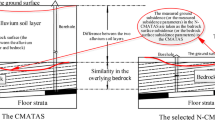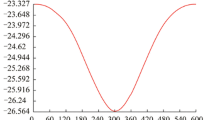Abstract
The entire overburden stratum above a coal mining area is considered to be composed of an alluvial soil layer and a bedrock layer. In underground mining, alluvial soil has a major effect on ground subsidence. This effect is especially significant and not negligible when the alluvial soil accounts for a large proportion in the entire overlying stratum of coal mining areas covered with thick alluvial soil (CMATASs). In this study, the applicability of the most popular probability integral method (PIM) used for CMATASs was analyzed, and it was found that the PIM is not suitable for ground subsidence prediction in CMATASs for two main reasons: (1) the subsidence basin range predicted by the PIM was smaller than the measured range; thus, the predicted basin converged more rapidly than the measured basin at the edges. (2) Poor fitting results were obtained at the subsidence basin edge. The mechanism of mining subsidence in CMATASs and the reasons why the PIM is not suitable for CMATASs were investigated in terms of the internal deformation and crack (void) distribution within the rock mass induced by underground coal mining. The results indicate that the alluvial soil is compacted and then subsides under vertical compression deformation, which increases ground subsidence. The bedrock is subjected to the weight/load of the thick alluvial soil layer. Because of the vertical compression deformation inside the rock, its internal voids (spaces) are compacted; thus, the replaced voids (spaces) are transferred to the ground surface, resulting in an increase in ground subsidence. However, the effect of the alluvial soil on ground subsidence cannot be detected by the PIM; moreover, the PIM is unable to represent the mechanism of the mining subsidence in CMATASs. Thus, the PIM cannot be used for predicting subsidence in CMATASs. To precisely calculate subsidence in CMATASs, we propose a combined prediction model (CPM) for mining subsidence in CMATASs based on soil mechanics and stochastic medium theory. The new CPM was applied to the mining process in the Huainan Coal Mining Area. The calculation results show that subsidence predicted by the CPM better fits the measured subsidence values, with a relative error of 4.9%, and that the fitting accuracy is improved by 18% compared to the relative error of the PIM (6.0%). Thus, the proposed CPM is more suitable for predicting ground subsidence caused by underground coal mining in CMATASs, and can be used to provide more accurate predictions for ground subsidence in similar coal mining areas.

















Similar content being viewed by others
References
Alejano LR, Ramirez-Oyanguren P, Taboada J (1999) FDM predictive methodology for subsidence due to flat and inclined coal seam mining. Int J Rock Mech Min Sci 36:475–491. doi:10.1016/S0148-9062(99)00022-4
Asadi A, Shakhriar K, Goshtasbi K (2004) Profiling function for surface subsidence prediction in mining inclined coal seams. J Min Sci 40:142–146
Asadi A, Shahriar K, Goshtasbi K, Najm K (2005) Development of a new mathematical model for prediction of surface subsidence due to inclined coal-seam mining. J South Afr Ins Min Metall 105:15–20
Baochen L, Ronggui Y (1981) The basic rules of displacement of rock mass due to underground mining. J China Coal Soc 1:40–55
Brady BHG, Brown ET (2004) ROCK mechanics for underground mining, 3rd edn. Springer, Dordrecht
Bureau HCM, Mine LTZC, Branch TC (1983) Mining under the Huaihe River and its embankment (in Chinese). Mine Surv 1:26–33
Cui XM, Fang ZH, Zuo HF, Li HX (2000a) effect of aquifer water loss caused by underground mining on the surface subsidence. Coal Geol Explor 28:47–48
Cui XM et al (2000b) Improved prediction of differential subsidence caused by underground mining. Int J Rock Mech Min Sci 37:615–627. doi:10.1016/S1365-1609(99)00125-2
Cui XM, Wang JC, Liu Y (2001) Prediction of progressive surface subsidence above longwall coal mining using a time function. Int J Rock Mech Min Sci 38:1057–1063
Djamaluddin I, Mitani Y, Esaki T (2011) Evaluation of ground movement and damage to structures from Chinese coal mining using a new GIS coupling model. Int J Rock Mech Min Sci 48:380–393. doi:10.1016/j.ijrmms.2011.01.004
Ge X, Yu G (2006) Influence of underground mining on ground surface and railway bridge under thick alluvium. J China Univ Min Technol 16:97–100
Gong X (1996) Advanced soil mechanics. Zhejiang University Press, Hang Zhou
Hao Q (1988) Void diffusion model for mined strata and analysis of influence of void sources (in Chinese). J China Univ Min Technol 02:30–36
Hao Q, Ma W (1985) On the methods of ground subsidence prediction (in Chinese). J China Univ Min Technol 02:37–42
Hao Q, Ma W (1986) The optimum from of weibull distribution subsidence equation and its application in surface subsidence calculation (in Chinese). J China Univ Min Technol 03:32–42
He G (1982) Application of influence function of Weber distribution to the precalculation of ground surface movement: a study on the fundamental law of ground movement based on the clastic theory. J China Univ Min Technol 1:1–20
He G, Yang L, Ling G, Jia C, Hong D (1991) Mining subsidence science. China University of Mining and Technology Press, Xuzhou
Huayang D, Xugang L, Jiyan L, Yixin L, Yameng Z, Weinan D, Yinfei C (2010) Model study of deformation induced by fully mechanized caving below a thick loess layer. Int J Rock Mech Min Sci 47:1027–1033
Holla L (1997) Ground movement due to longwall mining in high relief areas in New South Wales, Australia. Int J Rock Mech Min Sci 34:775–787
Kratzsch H (1983) Mining subsidence engineering. Springer, Berlin
Li L, Wu K, Zhou DW (2014) AutoCAD-based prediction of 3D dynamic ground movement for underground coal mining. Int J Rock Mech Min Sci 71:194–203. doi:10.1016/j.ijrmms.2014.04.025
Liang Q, Wen X, He G, Chen Q, Yang J (2007) Study on calculation methods for surface subsidence caused by water loss of clay. J Min Safety Eng 24:105–108
Litwiniszyn J (1956) Application of the equation of stochastic processes to mechanics of loose bodies. Arch Mech Stos 8:393–411
Litwiniszyn J (1974) Stochastic methods in mechanics of granular bodies. Springer, Vienna
Liu Y (1981) Surface movements, overburden failure and its application. Coal Industry, Beijing
Liu Y, Dai H, Jiang Y (2012) Model test for mining-induced movement law of rock and soil mass under thick unconsolidated layers. J Min Safety Eng 29:268–272
Miao X, Cui X, Ja W, Xu X (2011) The height of fractured water-conducting zone in undermined rock strata. Eng Geol 120:32–39. doi:10.1016/j.enggeo.2011.03.009
Peng SS (1992) Surface subsidence engineering. Littleton Society for Mining, Metallurgy, New York
Peng S, Zhang J (2007) Engineering geology for underground rocks. Springer, Berlin
Qian MG (1982) A study of the behavior of overlying strata in longwall mining and its application to strata control. Paper presented at the Proceedings of the Symposium on Strata Mechanics, New York
Qian M, Miao X, Xu J, Mao X (2003) Study of key strata theory in ground control. China University of Mining and Technology Press, Xuzhou
Qian MG, Shi PW, Xu JL (2010) mining pressure and strata control. China University of Mining and Technology Press, Xuzhou
Reddish DJ, Whittaker BN (2012) Subsidence occurrence, prediction and control, vol 56. Elsevier, Amsterdam
Sheorey PR, Loui JP, Singh KB, Singh SK (2000) Ground subsidence observations and a modified influence function method for complete subsidence prediction. Int J Rock Mech Min Sci 37:801–818. doi:10.1016/S1365-1609(00)00023-X
Singh RP, Yadav RN (1995) Prediction of subsidence due to coal mining in Raniganj coalfield, West Bengal, India. Eng Geol 39:103–111
State Bureau of Coal Industry (2004) The regulation of leaving coal pillar and mining coal of holding under the buildings, water bodies, railways and the main roadway. Coal Industry, Beijing
Sui W (1992) Mechanism and prediction of soil mass deformation due to mining subsidence (in Chinese). China University of Mining and Technology, Xuzhou
Tan Z, Deng K, Yang J (2002) Research on ground movement laws for strip mining under thick alluvium. J China Univ Min Technol 12:61–64
Wu K, Ge J, Wang LD, Zhou M (1998) Unify method of mining subsidence prediction. China University of Mining and Technology Press, Xuzhou
Wu K, Deng K, Zhou M, Huang Z, Zheng Y, Wang Z (1999) The analysis of monitor conclusion about overburden displacement under condition of fully mechanized sublevel caving. J China Coal Soc 24:21–24
Wu K, Jin J, Dai Z, Jiang J (2002) The experimental study on the transmit of the mining subsidence in soil. J China Coal Soc 27:601–603
Wu Q, Fan S, Zhou W, Liu S (2013) Application of the analytic hierarchy process to assessment of water Inrush: a case study for the No. 17 Coal Seam in the Sanhejian Coal Mine. China Mine Water Environ 32:229–238
Xu Z (2006) Elastic mechanics. Higher Education, Beijing
Yin Z (2007) The principle of geotechnical engineering. China Water Power, Beijing
Yuan L, Wu K (2003) Theoretical research and technology practice on mining under the Huaihe River embankment. China University of Mining and Technology Press, Xuzhou
Zhang X, Zhao Y, Liu S (1999) A new method of calculating surface subsidence and deformations under thick alluvial soil the Chinese. J Nonfer Metals 9:435–440
Zhou DW (2014) The synergy mechanism between rock mass and soil in mining subsidence and its prediciton (in Chinese). China University of Mining and Technology Press, Xuzhou
Zhou DW, Wu K, Cheng GL, Li L (2015) Mechanism of mining subsidence in coal mining area with thick alluvium soil in China. Arab J Geosci 8:1855–1867. doi:10.1007/s12517-014-1382-2
Zhou D, Wu K, Li L, Diao X, Kong X (2016a) A new methodology for studying the spreading process of mining subsidence in rock mass and alluvial soil: an example from the Huainan coal mine, China. Bull Eng Geol Environ 75:1067–1087. doi:10.1007/s10064-016-0877-3
Zhou DW, Wu K, Li L, Yu JW (2016b) Impact of thick alluvial soil on a fractured water-conducting zone: an example from Huainan coal mine, China. J South Afr Inst Min Metall 116:431–440. doi:10.17159/2411-9717/2016/v116n5a9
Acknowledgements
This research has been financially supported by the National Natural Science Foundation of China (Grant Numbers: 51604266, 51504239 and U1361203), the Natural Science Foundation of Jiangsu province (BK20150187), the Priority Academic Program Development of the Jiangsu Higher Education Institutions (PAPD). The authors express their special thanks to the research and support provided by Huainan Mining Industry (Group) Co., Ltd., and the National Engineering Lab of Coal Ecological Environment Protection. The financial support from all the above mentioned sources is gratefully acknowledged. The authors are also grateful to the reviewers of this paper for their comments.
Author information
Authors and Affiliations
Corresponding author
Rights and permissions
About this article
Cite this article
Zhou, D., Wu, K., Miao, X. et al. Combined prediction model for mining subsidence in coal mining areas covered with thick alluvial soil layer. Bull Eng Geol Environ 77, 283–304 (2018). https://doi.org/10.1007/s10064-016-0961-8
Received:
Accepted:
Published:
Issue Date:
DOI: https://doi.org/10.1007/s10064-016-0961-8




